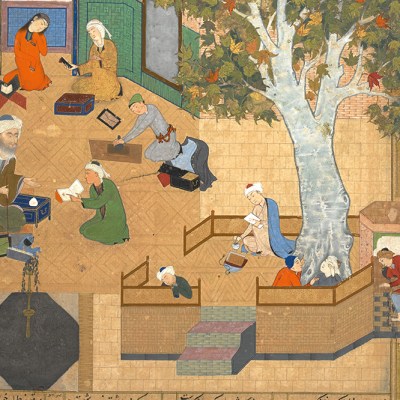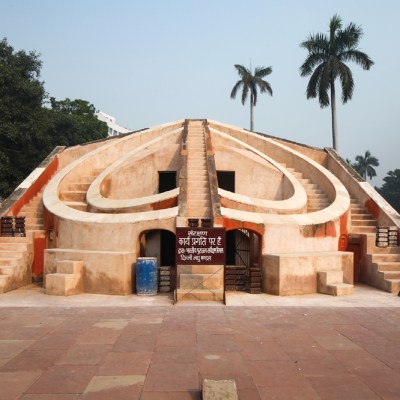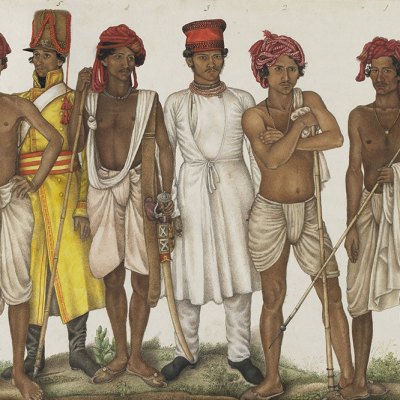A mid 17th-century painting attributed to the Mughal artist Abid shows Prince Khurram (who would become the Mughal emperor Shah Jahan) bidding farewell to his father, the emperor Jahangir, before departing for his first military campaign in the Deccan. The royal figures appear on a high balcony, attended by a solitary figure. The pale background behind them shimmers with delicate gold ornamentation. Under them, against a vibrant jade-green backdrop, stands a watchful crowd of courtiers whose finely individualised features and multi-coloured clothes serve as a silent testimony to the diversity of the Mughal court. Abid’s careful composition splits the painting in two: the drama of the farewell between the two royal figures is both intensely private and a superb public performance of filial duty. The railings of the imperial balcony and the public court picked out in gold echo the ornamental border that surrounds the painting. As viewers, we are as much a part of the action as the rows of observers in the painting, and as distant as they are from the prince and the emperor.
Padshahnamah – Prince Khurram departs from Ajmer for his first Deccan campaign (30 October 1616) (c. 1635–40), attributed to Abid, with nastaliq calligraphy by Muhammed Amin Mashhadi. Royal Collection Trust/© His Majesty the King Charles III 2023
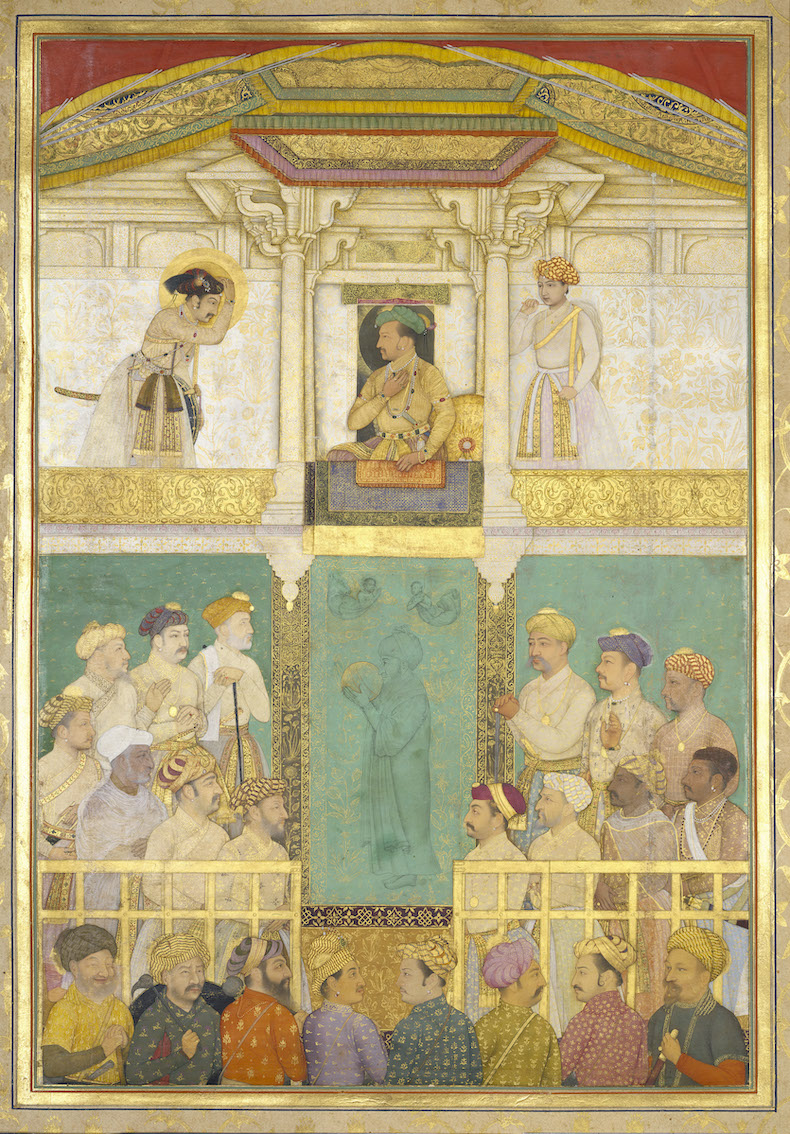
That playing with the viewer through a simultaneous push and pull, inviting them in while keeping them at a distance, is typical of the miniatures that were produced by the Mughal imperial studios. Some of them were standalone works of art, others were bound into albums, or else specially commissioned to accompany texts such as the Padshahnama, the chronicle of the reign of Shah Jahan, in which Abid’s painting makes its appearance. Intricacy and intimacy are their defining features. They tend to be small – Abid’s painting is only slightly larger than an A4 sheet of paper – often set within elaborate framing of pattern and text. You were meant to pore over them, appreciating the fine line of the brush, the delicacy of shading, yet the exquisiteness of their world was set markedly apart from yours.
The Quintet of Navai Rabia al-Adawiya (The Kaaba moves for Saint Rabia al-Adawiya) (c. 1605–10), Govardhan. Royal Collection Trust/© His Majesty King Charles III 2023
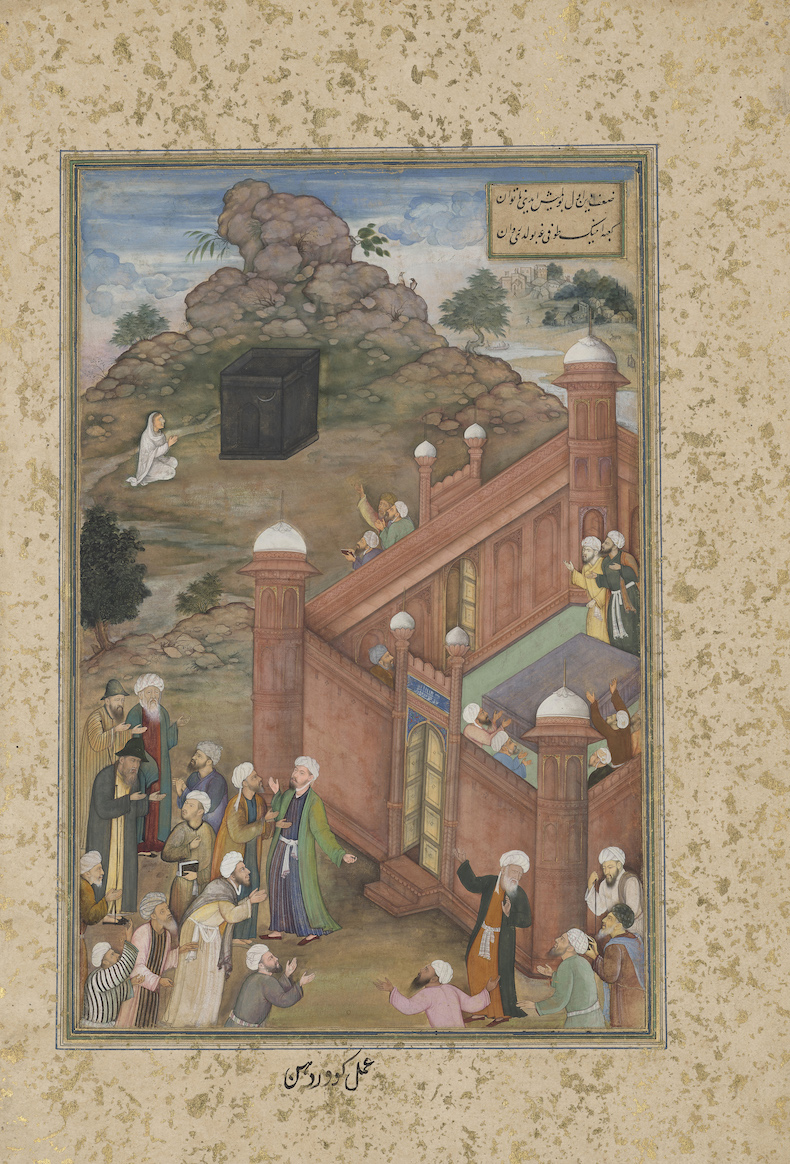
As an exhibition at the MK Gallery in Milton Keynes, ‘Beyond the Page: South Asian Miniature Painting and Britain, 1600 to now’, points out, ‘miniature’ is a relative term. What matters to this collection is not size, but style and artistic practice. Across an extensive selection of around 180 works – including a number of rarely-displayed early examples come from the British Royal Collections – it traces the legacies of the miniature as a painting tradition. The display revels in striking juxtapositions. An early section features the touching intimacy of a painting of the ninth-century saint Rabia al-Adawiyya of Basra, the first female saint in Sufi Islam, the details of whose face have faded to white through repeated touching for blessings. That picture shares the wall with The Scroll (1989–90), a sprawling, almost two-metre-long work by Lahore-trained Shazia Sikander, in which the artist depicts herself as a ghostly, faceless white figure moving through a stylised unfolding of her teenage home in a restless quest for identity. Other echoes are equally attention-grabbing, from Imran Qureshi’s excoriating Blessings Upon the Land of My Love (2011), in which blood splatters blossom across a Mughal-style courtyard painted in gouache and gold leaf, to the composite elephant made of consumer brand logos that strides towards ecological disaster in the Singh Twins’ lightbox work Because You’re Worth It? II (2022).
A Lover Waiting for his Beloved (1999), Imran Qureshi. Private collection, London/Karachi; © the artist
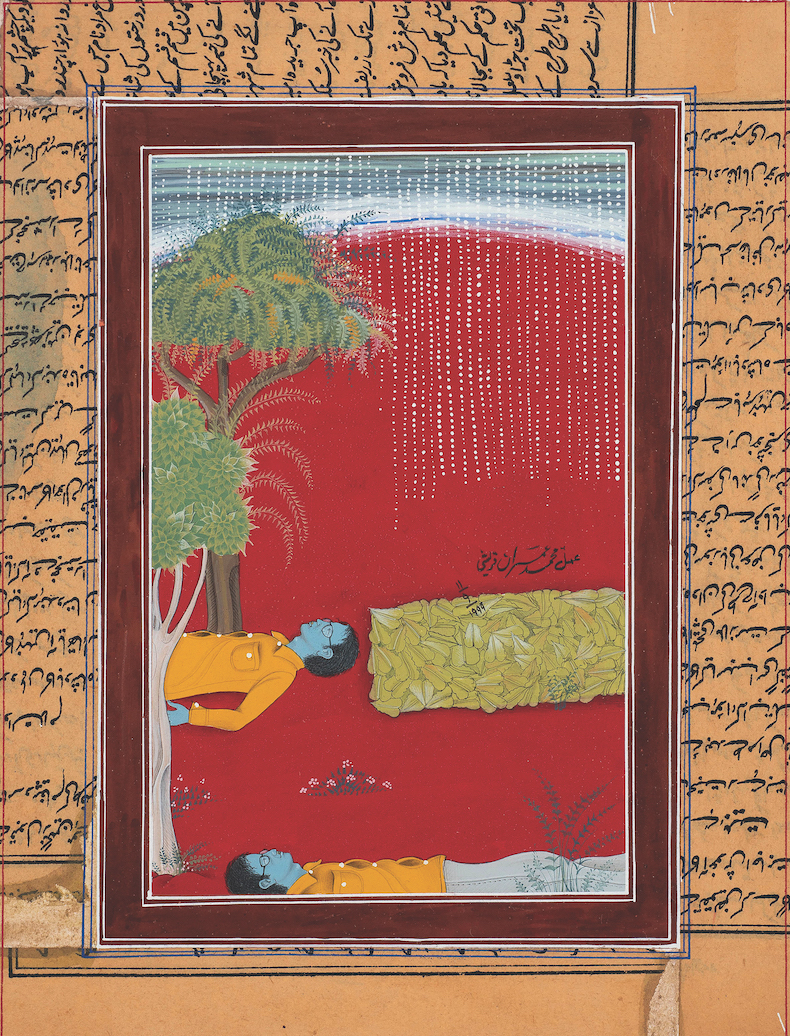
Those looking to follow the exhibition catalogue’s promised focus on ‘the role that Britain’s incursions into South Asia played in the evolution of the miniature painting tradition’ will find another, chronological narrative unfolding alongside this creative juxtaposition. That story begins roughly around 1616, when the first ambassador of a struggling island nation appeared at Jahangir’s court to petition for a trading licence that would allow his countrymen to trade within the Mughal empire. Sir Thomas Roe, sent jointly by James I of England and the recently formed East India Company, had bonded with the emperor over a shared appreciation of miniatures. His embassy had little success, but as European and British colonial presence took hold in the centuries that followed, there would be other collectors and artists, such as Willem Schellinks, whose darkly theatrical Parade of the Sons of Shah Jahan (c. 1660) copies from a Mughal album also studied by Rembrandt. That interest would come almost a full circle a couple of centuries later, when under the encouragement of the then-principal of the Government School of Art in Calcutta, E.B. Havell, Indian artists such Ishwari Prasad and Abanindranath Tagore had embarked on a rediscovery of indigenous art traditions. Abanindranath Tagore’s own delicate paintings, combining Japanese paint wash techniques with Mughal architectural framing, stand implicitly behind one particular watercolour sketch tucked into a corner of the gallery’s display: a 1924 draft by William Rothenstein for the mural of Roe’s embassy that he was commissioned to paint in the Houses of Parliament, part of a national morale-building exercise after the end of the Great War.
Here, too, the interweaving of pieces by contemporary artists provides a counterpoint to the history of empire, appropriation, erasure and rediscovery. Forty-one tiny, exquisitely detailed portrait studies of representative ‘native’ figures produced in late 18th-century colonial Bengal on a single sheet of paper gesture towards the recent work that has emerged in response: Ali Kazim’s Children of Faith portraits of 2023 are suspended equally out of context, the tenderness of their depiction a discordant juxtaposition with the mathematical precision of the grid in which they are arranged. In another section of the exhibition, Nusra Latif Qureshi’s Did You Come Here to Find History (2009) resonates with both: a nine-metre scroll of digital film suspended down the centre of the gallery, it superimposes the artist’s passport photo on Venetian and Mughal portraits. Faces flicker as visitors walk past, evoking childhood memories of lenticular images, enfolding the past and the present, the avowedly spectacular and the everyday, the memorialised and the erased.
Did you come here to find history? (2009; detail). Courtesy and © the artist

There is a third strand, of course, that accompanies any visitor from the first label they read, with its usual offering of information about provenance and current ownership. As Emily Hannam’s essay in the catalogue points out, this exhibition, exhaustive as it is, barely scratches the surface, as ‘tens of thousands’ of South Asian miniatures are currently held in British collections, both public and private: testimony to the way in which dissociation of the colonised from both indigenous traditions and indigenous artefacts is an inextricable part of the colonial legacy. In Hamra Abbas’s work All Rights Reserved (2004), that troubled history itself becomes the focus, as she plays with a copy of the Mughal painting of Presents for Prince Dara Shikoh’s wedding in December 1632 (c. 1640) from the Padshahnama, presented to George III and still part of the Royal Collection. In Abbas’s version, the gifts carried by bearers in the original painting are cut out digitally and transposed to a separate panel. Between the two panels, the title page and copyright terms of the lavish 1997 exhibition catalogue that featured both the Padshahnama and the painting stands sentinel. This, too, is a familiar push and pull – the simultaneous acknowledgement of value and denial of access – that still haunts South Asian art collections today.
‘Beyond the Page: South Asian Miniature Painting and Britain, 1600 to Now’ is at the MK Gallery, Milton Keynes, until 28 January.

